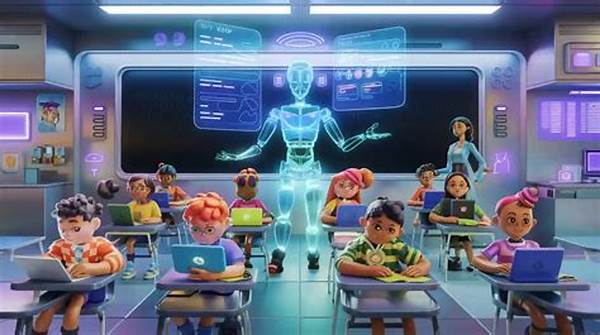Why Schools Are Adopting AI Learning Tools
In today’s rapidly evolving educational landscape, a new player is making waves and capturing the attention of educators and administrators worldwide: Artificial Intelligence (AI). As technology permeates every aspect of our lives, it’s only natural that schools are adopting AI learning tools to enhance the educational experience. This doesn’t just sound futuristic—it brings distinct advantages that can revolutionize how students learn, how teachers teach, and how educational materials are delivered. Imagine a classroom where each student has a personalized assistant that adapts to their learning pace, identifying areas where they excel and those requiring more focus. This is not a dream but a growing reality powered by AI. So, why exactly are educational institutions embracing AI with open arms? Let’s embark on this exploratory journey through classrooms that are evolving faster than ever before, armed with AI capabilities designed to spark curiosity, innovation, and learning tailored to individual needs.
Read More : How Ai Supports Teachers And Learners Equally
Traditionally, the education system followed a one-size-fits-all model, but with AI, this is markedly shifting. AI learning tools offer educators real-time insights into student performance and engagement, enabling them to tailor lessons accordingly. It’s like having a smart assistant that helps teachers reach every student, catering to varied learning styles and abilities. This transformation is much lauded not just by educators but also by students and parents who notice the personalized attention AI aids provide. The use of AI in education is elevating learning experiences, turning challenges into opportunities and unlocking potential in ways previously unimagined.
Moreover, teachers stand to benefit significantly from AI. By automating administrative tasks, AI frees up teachers’ time, allowing them to focus more on teaching and interacting with students. This reduction in workload is crucial in a sector where burnout rates are alarmingly high. AI tools also provide data-driven insights which equip teachers with precise knowledge about a student’s strengths and difficulties, enabling a more targeted educational approach. It’s an exciting synergy of human expertise and machine intelligence, driving a new age of learning.
The Impact on Student Engagement and Learning
Studies conducted by educational institutions using AI tools have shown remarkable increases in student engagement and improved learning outcomes. AI-driven applications analyze student interactions and adapt the content in innovative ways to ensure students remain engaged. This makes education not just informative but also interactive and fun, fostering a love for learning in students of all ages.
—
The Purpose Behind AI Adoption in Schools
The primary reason why schools are adopting AI learning tools is to foster an inclusive learning environment that accommodates diverse learners and enhances educational outcomes. With AI, personalized learning becomes accessible to every student, regardless of their starting point, ensuring equal learning opportunities. AI tools analyze and adapt to the student’s learning curve, providing the right level of challenge to stretch their capabilities effectively.
Enhancing Teachers’ Capabilities
A significant purpose is to augment teachers’ capabilities. By having an AI by their side, teachers can deliver more personalized instruction without the heavy burden of repetitive tasks like grading or organizing classroom materials. This empowerment allows them to focus more on mentoring and inspiring students—key ingredients in quality education.
Technological Leap in Education
AI embodies a technological leap in education, bringing with it a promise of enhanced efficiency and innovation. This leap encourages a digital re-skilling for both educators and students, preparing them for a tech-driven future. The insights gained from AI tools are invaluable for curriculum development, identifying gaps, and optimizing educational content based on real-time feedback.
Moreover, AI brings an intriguing element of excitement into the classroom. Imagine a math problem coming to life as an interactive 3D model or historical events being reimagined through virtual reality. Such immersive experiences are not just fun—they are deeply impactful, offering multiple sensory interactions that enhance memory and understanding.
In addition to enriching the present, AI learning tools future-proof students by equipping them with skills essential for tomorrow’s digital world. Critical and analytical thinking, problem-solving, and adaptability—these life skills are naturally integrated into AI-driven education. This strategic alignment between schooling and future workforce needs underscores why schools are adopting AI learning tools in growing numbers. The impact of artificial intelligence on education is just beginning to unfold, making this an exciting era for both educators and learners alike.
Nine Reasons Behind the Adoption of AI Learning Tools in Schools
—
The Broader Picture: AI in Educated Society
AI is gradually becoming an emblem of educated societies that place a high value on learning and adaptability. It reshapes our perceptions of what learning means and looks like in the modern age. But as schools take the helm in this transformative journey, so too must communities and policymakers recognize their role in fostering robust AI infrastructure. This integration requires investment in both technology and professional development, ensuring educators are comfortable and proficient in using these tools. The question isn’t only why schools are adopting AI learning tools but how society as a whole can appear ready for such groundbreaking integration.
A Collaborative Approach
A noteworthy aspect of AI integration in schools is the collaboration between tech companies and educational institutions. Often, these partnerships result in custom solutions tailored to specific educational needs, ensuring that AI tools are both relevant and effective. Interviews with tech developers and educators reveal a shared goal: advancing learning through technology and enhancing the educational process.
AI is no silver bullet, however. The narrative of AI in education also addresses ethical considerations, such as data privacy and the digital divide. AI tools must be designed to protect student information and ensure equal access to technology, preventing further societal inequalities. These challenges necessitate a conscientious approach to AI adoption, guided by ethical standards and inclusive practices.
Looking Ahead
The future of AI in education is bright yet demands cautious optimism. As these tools mature, so too will their capacity to address educational challenges. Schools are not just adopting AI learning tools; they are embracing a new educational frontier where creativity, curiosity, and collaboration are at the heart of the student experience. Embracing AI is about more than technology—it’s about preparing for tomorrow’s world today.
—
Illustrations of AI Adoption in Schools
Beyond the Hype: AI’s Role in Educational Transformation
AI’s presence in education extends far beyond the hype and buzzwords. Schools adopting these tools are investing in a future-oriented strategy that capitalizes on AI’s strengths to boost learning outcomes and overall educational experiences. But as they say, with great power comes great responsibility. Educators are tasked with not only implementing AI intelligently but also ensuring its positive impact aligns with learning goals and ethical standards.
To achieve this, ongoing research and evaluation are needed—what works, what needs revision, and what the future holds. This process involves dialog between educators, students, parents, and AI developers to make informed decisions that benefit all stakeholders. AI has the potential to remove learning barriers, create opportunities, and inspire a generation that thrives on innovation and knowledge.
In conclusion, AI learning tools are more than just tech enhancements; they represent an educational evolution with profound implications. Schools are not only adopting these tools to keep pace with technological change but to lead the education sector into a new era of possibility, ensuring no student is left behind in this exciting journey of learning and discovery.


